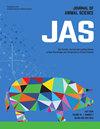Xylo-oligosaccharides enhance intestinal and thymic immunity by modulating pyroptosis, gut microbiota and Th17/Treg immune response in LPS-challenged piglets
IF 2.7
2区 农林科学
Q1 AGRICULTURE, DAIRY & ANIMAL SCIENCE
引用次数: 0
Abstract
Xylo-oligosaccharides (XOS) have been shown to improve the immune system of weaned piglets, but the molecular mechanism of their action remains unclear. Therefore, this study aimed to investigate the impact of XOS on intestinal and thymic immune function in weaned piglets challenged with lipopolysaccharide (LPS) and elucidate the underlying mechanism. In a 2 × 2 factorial arrangement, consisting of diet treatment (basal diet vs 0.02% XOS diet) and immunological challenge [saline vs LPS], 24 piglets were randomly divided into four groups (n = 6): CON group, basal diet + saline; LPS group, basal diet + LPS; XOS group, 0.02% XOS diet + saline; XOS_LPS group, 0.02% XOS diet + LPS. Piglets were fed either the basal or XOS diet for 21 days, followed by intraperitoneal injections of normal saline or LPS on the 22nd day. Ileum, thymus and colon samples were collected 4 hours after the intraperitoneal saline or LPS injection. The piglets fed XOS diet had higher average daily feed intake and average daily weight gain (P < 0.05). The XOS diet increased ileal villus height and decreased crypt depth. XOS also enhanced ileal and thymic antioxidant enzyme activities, anti-inflammatory cytokine expression, and decreased malondialdehyde levels and mRNA abundance of proinflammatory cytokines in piglets (P < 0.05). The XOS diet also downregulated ileal and thymic NOD-like receptor family pyrin domain containing 3 and gasdermin-D gene and protein expression associated with pyroptosis (P < 0.05). Moreover, The XOS diet increased the mRNA abundance of forkhead box P3, signal transducer and activator of transcription 5, and transforming growth factor beta 1 while decreasing signal transducer and activator of transcription 3 and retinoid-related orphan receptor-gammat mRNA abundance (P < 0.05). The XOS diet enhanced forkhead box P3 protein expression and reduced retinoid-related orphan receptor-gammat protein expression following the LPS challenge (P < 0.05). At the same time, The XOS diet affected the gut microbiota and increased levels of short-chain fatty acids (P < 0.05). In conclusion, XOS may modulate ileal and thymic immune function in weaned piglets following a 4-hour LPS challenge by affecting gut microbiota, pyroptosis and Th17/Treg immune responses.求助全文
约1分钟内获得全文
求助全文
来源期刊

Journal of animal science
农林科学-奶制品与动物科学
CiteScore
4.80
自引率
12.10%
发文量
1589
审稿时长
3 months
期刊介绍:
The Journal of Animal Science (JAS) is the premier journal for animal science and serves as the leading source of new knowledge and perspective in this area. JAS publishes more than 500 fully reviewed research articles, invited reviews, technical notes, and letters to the editor each year.
Articles published in JAS encompass a broad range of research topics in animal production and fundamental aspects of genetics, nutrition, physiology, and preparation and utilization of animal products. Articles typically report research with beef cattle, companion animals, goats, horses, pigs, and sheep; however, studies involving other farm animals, aquatic and wildlife species, and laboratory animal species that address fundamental questions related to livestock and companion animal biology will be considered for publication.
 求助内容:
求助内容: 应助结果提醒方式:
应助结果提醒方式:


